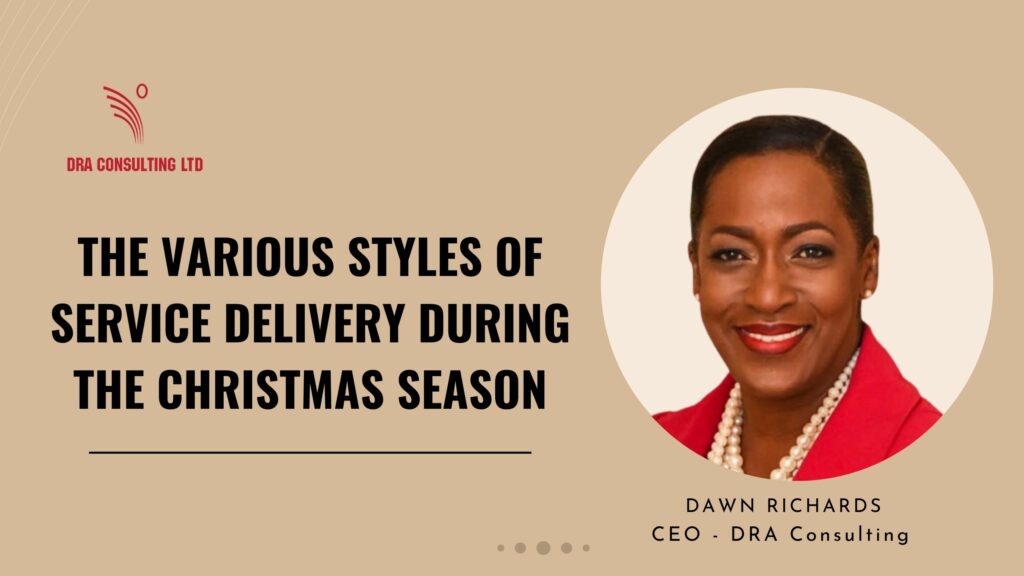The holiday season brings out the good, the bad and the worst in service delivery. Businesses are stocked beyond capacity and shoppers are busy looking for their treasures. Whilst there is a level of inventory stockpiling for the onslaught of customers, many businesses buckle under the weight of customer interactions. They just don’t have the bandwidth to be responsive to the many customer demands. It’s possible that the bandwidth failure occurs because service excellence is excluded from the season’s strategy playbook. Maybe it’s not deemed important enough to have its own strategy.
Apart from the marketing spend that typifies the season, four additional revenue influencers that I believe qualify for inclusion in the strategy playbook are inventory management, human resources, payment solutions and customer experience. The first two show up every year of course, whilst the latter two are often afterthoughts in the planning and provisioning process. If I had my way, I would ensure that all four of these influencers are afforded similar “strategic weight,” to forestall lop-sidedness in serving customers.
Unfortunately, lop-sidedness is a common occurrence during the season and this gives rise to varying styles of service delivery. Three styles that come to mind are under-willingness, under-preparedness and under-estimation.
The holiday season brings out the good, the bad and the worst in service delivery.
Under-willingness is a style that shows up during hectic seasons like Christmas time, at three levels; strategic, operational and direct-facing customer interactions. Firstly, there’s an under-willingness at the strategic level to put in the effort to meet customers’ expectations, because the executive focus is on sales. Of course, if pressure is applied to driving sales, then the operational level will dance to the beat of the drum.
Under-preparedness is a sticking point. Every year, we have twelve months’ notice that Christmas is coming. So, there’s no reason why businesses should not have a plan in place for not only sales, but also for delightful customer experiences. There needs to be as much of a customer engagement strategy, as there is a sales and marketing strategy. Whilst I do understand the delicate balancing act between sales and cost of sales, the opportunity cost of not adding value to the shopping experience should not be ignored.
Under-estimation of customer and user expectations is a big consideration during regular seasons, but at peak seasons, its impact can cripple a business. We know that online shopping expands exponentially at Christmas time, so there are more instances to win or lose with the user experience. If prior to the peak season, there were customer complaints about their frictional experience during interaction with a website or app, the problem can be expected to expand at peak times, if not remediated.
Apart from the marketing spend that typifies the season, four additional revenue influencers that I believe qualify for inclusion in the strategy playbook are inventory management, human resources, payment solutions and customer experience.
The ripple effect of sales minus service, will bleed into customer interactions at both customer-facing and at e-commerce levels. The ultimate result will be that although sales targets may be met, the bitter after-taste of frustration will be remembered by customers. No wonder individuals direct so much of their spending to brands that have created frictionless experiences.
Nevertheless, there have been bright spots in the experience universe. For in-person shopping, some retailers have reconfigured cashier’s counters to accommodate express checkouts and have placed willing and eager-to-assist employees at the frontline. Equally helpful, has been the widening of both in-person and online payment solution options, which augurs well for driving online shopping and digital marketing. These moves reduce customer frustration significantly.
The one pitfall that businesses should do everything in their power to avoid during any season and especially during the Christmas rush, is customer frustration. It is an Achilles heel for service excellence. Under-willingness, under-preparedness and underestimation all lead to customer frustration, which in turn, causes customer defection.
Every year, we have twelve months’ notice that Christmas is coming. So, there’s no reason why businesses should not have a plan in place for not only sales, but also for delightful customer experiences.
By now, regular readers of this column know that I preach incessantly about the need for businesses to track the quality of both service delivery and customer experience. It’s the starting point for transforming ordinary service delivery into extraordinary customer experience and, just in case you were wondering, it’s never too late to course correct.
Let me take this opportunity to express my appreciation to the loyal readers of this column. Your words of encouragement, points of disagreement and most of all, suggestions for how we can improve our service to each other as citizens of this country, are valued.
I say a heartfelt “Thank you” and extend best wishes for a joy-filled Christmas to those who will be celebrating this holiday season.

